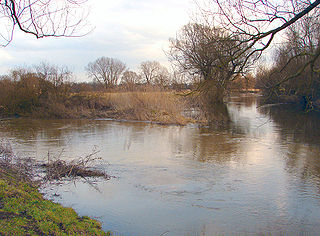
Lower Saxony is a German state in northwestern Germany. It is the second-largest state by land area, with 47,614 km2 (18,384 sq mi), and fourth-largest in population among the 16 Länder federated as the Federal Republic of Germany. In rural areas, Northern Low Saxon and Saterland Frisian are still spoken, albeit in declining numbers.
Gifhorn is a district in Lower Saxony, Germany.
Schaumburg is a district (Landkreis) of Lower Saxony, Germany. It is bounded by the districts of Nienburg, Hanover and Hamelin-Pyrmont, and the state of North Rhine-Westphalia.
Hameln-Pyrmont is a district (Landkreis) in Lower Saxony, Germany. It is bounded by the districts of Schaumburg, Hanover, Hildesheim and Holzminden, and by the state of North Rhine-Westphalia.
Hanover Region is a district in Lower Saxony, Germany. It is bounded by the districts of Heidekreis, Celle, Gifhorn, Peine, Hildesheim, Hamelin-Pyrmont, Schaumburg and Nienburg.
Hildesheim is a district (Landkreis) in Lower Saxony, Germany. It is bounded by the districts of Hanover, Peine, Wolfenbüttel, Goslar, Northeim, Holzminden and Hamelin-Pyrmont.

Salzgitter is an independent city in southeast Lower Saxony, Germany, located between Hildesheim and Braunschweig. Together with Wolfsburg and Braunschweig, Salzgitter is one of the seven Oberzentren of Lower Saxony. With 101,079 inhabitants and 223.92 square kilometres (86.46 sq mi), its area is the largest in Lower Saxony and one of the largest in Germany. Salzgitter originated as a conglomeration of several small towns and villages, and is today made up of 31 boroughs, which are relatively compact conurbations with wide stretches of open country between them. The main shopping street of the young city is in the borough of Lebenstedt, and the central business district is in the borough of Salzgitter-Bad. The city is connected to the Mittellandkanal and the Elbe Lateral Canal by a distributary. The nearest metropolises are Braunschweig, about 23 kilometres to the northeast, and Hanover, about 51 km to the northwest. The population of the City of Salzgitter has exceeded 100,000 inhabitants since its foundation in 1942, when it was still called Watenstedt-Salzgitter. Beside Wolfsburg, Leverkusen and Eisenhüttenstadt, Salzgitter is one of the few cities in Germany founded during the 20th century.
Wolfenbüttel is a district in southeastern Lower Saxony, Germany. Neighboring districts are the district-free City of Braunschweig, the district of Helmstedt, the district of Harz in Saxony-Anhalt, and the districts of Goslar, Hildesheim and Peine. The district-free city of Salzgitter cuts through the district of Wolfenbüttel in the southwest.
Holzminden is a district in Lower Saxony, Germany, with the town of Holzminden as its administrative capital. It is bounded by the districts of Hamelin-Pyrmont, Hildesheim and Northeim, and by the state of North Rhine-Westphalia.

Schunter is a river in Lower Saxony, Germany. It has a length of 58 km (36 mi) and is a right tributary of the Oker.

The Province of Lower Silesia was a province of the Free State of Prussia from 1919 to 1945. Between 1938 and 1941 it was reunited with Upper Silesia as the Province of Silesia. The capital of Lower Silesia was Breslau. The province was further divided into two administrative regions (Regierungsbezirke), Breslau and Liegnitz.

Laatzen is a town in the district of Hanover, in Lower Saxony, Germany. It is situated directly south of Hanover.

Lübbenau is a town in the Upper Spree Forest-Lusatia District of Brandenburg, Germany. It is located in the bilingual German/Sorbian region of (Lower) Lusatia, on the river Spree, where this forms a large inland delta surrounded by woodland, called "Spree Forest", about 82 km (51 mi) southeast of Berlin. The town is best known through the incorporated villages of Lehde/Lědy and Leipe/Lipje, villages where there just exist anabranches of the Spree River instead of streets.

Liebenburg is a municipality in the district of Goslar, in Lower Saxony, Germany.

Lehre is a municipality in the district of Helmstedt, in Lower Saxony, Germany. The current population is 11,539 and is situated approximately 13 km (8.1 mi) southwest of Wolfsburg, and 12 km (7.5 mi) Braunschweig.
Thedinghausen is a Samtgemeinde in the district of Verden, in Lower Saxony, Germany. Its seat is in the village Thedinghausen. Until 1972 the incorporated municipalities had been an exclave of the district Braunschweig.

The Hildesheim–Brunswick line is a 43 km long electrified main line railway in the German state of Lower Saxony. It forms part of the Intercity-Express route from Frankfurt to Berlin. It is also used as a diversion route from the Hanover–Brunswick line. It is a single track line from Hildesheim to Groß Gleidingen. A proposal to duplicate the line was included in the Federal Transport Infrastructure Plan of 1992.
Gleidingen is a part of the town of Laatzen in the district of Hanover, in Lower Saxony, Germany. It is situated south of both Hanover and the center of Laatzen.

Essehof Zoo is a privately owned and operated zoo located in Essehof, a town within the municipality of Lehre, Lower Saxony, Germany. It opened in 1968 and currently consists of 10 hectares. It is located about 13 km (8.1 mi) northeast of Braunschweig.










